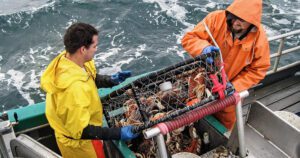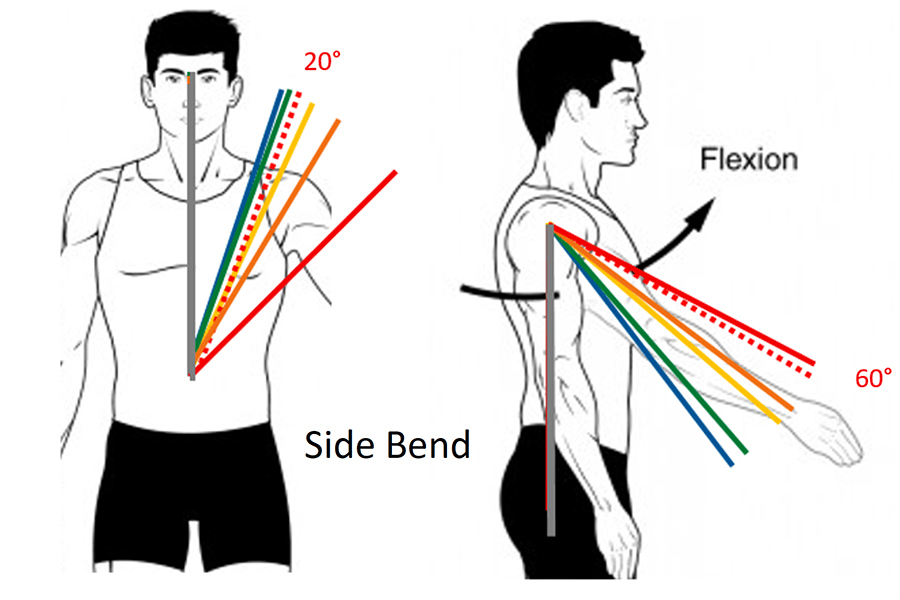
Many fishing vessels in the Pacific Northwest have installed bang bars (also known as banger bars) to assist crew while they empty Dungeness crab pots into the dump box.
There are a variety of designs and range of heights above the dump box or sorting table. The bang bar design depends on a lot of factors, including vessel design, deck layout, crew preference, and fabricator availability. As vessel owners think about what’s best for their situation, it is important to know how the bang bar design could maximize benefits to crew safety and health.
Ergonomics experts at Oregon State University (OSU) set out to do just that—find the ‘just right’ bang bar configuration.
Crabbing in the Lab
In the lab at OSU, we set up a simulated crab pot landing station without a bang bar and with four different bang bars designs: a straight design at a low (11 inches), medium (18 inches) and high (24 inches) setting above the dump box/sorting table, and a triangle bar that was at the same height as the high straight bar (24 inches).
In our lab simulation, we had two “deckhands” on either side of the sorting table and measured the deckhand on the “wet” side, which had the deckhand always bending to the left.
Researchers measured 25 deckhand’s stability, posture, and muscle activity while performing crab harvesting tasks in the lab to understand how the bang bar design might improve stability and reduce awkward postures and muscular loads.

Stability: Postural stability can be described as a person’s ability to stay upright and balanced and avoid falls that might lead to injury. Crew members handling the crab pot without bang bars had the least stability. Deckhands using the high bang bar and triangle bar had more than double the stability index of handling the crab pot without a bang bar.
Posture: Posture can be described as the position in which one holds their body. For landing crab pots, back and shoulder postures are most relevant to risk of injury. Greater side bending or shoulder flexion (i.e., raised arms) increase stress loads on the body and musculoskeletal pain/injuries when such awkward postures are repeated or prolonged.
Side bends greater than 20 degrees can increase back injury risk and we found that the high and triangle bar had the least side bending while the other bar conditions all had the crew bending more than 20 degrees.
Shoulder flexion (raising the arm in the forward direction) greater than 60 degrees can increase risk of shoulder injury. The high and triangle bar had the least shoulder flexion while handling the crab pot without the bang bar did result in shoulder flexion greater than 60 degrees.
Muscle Activity: Muscle activity can be described as the amount of effort (% effort relative to one’s maximum muscle strength) that it takes to complete an action. Higher levels of effort can increase tension on soft tissues (e.g., muscle and tendon) and faster development of muscle fatigue, which are associated with increased risk of injuries. We found that the higher bang bar and the triangle bar required the least effort for both the shoulder and low back muscles.
High or Triangle Bang Bars Are Best
It’s important to protect the health of crewmembers on crab fishing vessels and this work illustrates the benefits of banger bars and how the height of the bang bar can further reduce risk of injury among crewmembers. Ultimately, our results revealed that the straight high bar and triangle bar (both 24 inches tall above the sorting table) resulted in greater stability, less side bending and shoulder flexion, and lower muscle activity.
Our results showed that the right-side activity was greater than left side activity due to the direction the crew was working the pot, so changing sides at the sorting table may reduce unbalanced overuse of back and arms and therefore provide better protection from back and arm injury.
Cross training to ensure that all crew can run the block would allow crew members to rotate jobs on the deck. Swapping sides at the dump box would decrease the duration and even out the strain on muscles so both sides of the body are carrying the load rather than just on one side.
This cross training takes time but may have multiple benefits. Changing positions on deck helps reduce the risk of injury and has the potential to improve morale by having fishermen fully understand and share in all tasks.
Use a Bang Bar for Crew Safety and Good Crab
Some fishing vessels may be hesitant to use bang bars because of concerns that handling a pot using a bang bar may impact crab health, and therefore decrease its value. This concern is especially relevant for the vessels participating in the live market.
However, research that looked at factors, such as handling and how far the crab dropped, which may affect crab health during harvesting did not find any negative impacts for the situation a bang bar would create for the crab.
The study team for the project included Jay Kim, Laurel Kincl, Kiana Kia, Allen Chan, Justin Bunnell and Amelia Vaughan of Oregon State University’s College of Public Health and Human Sciences.
